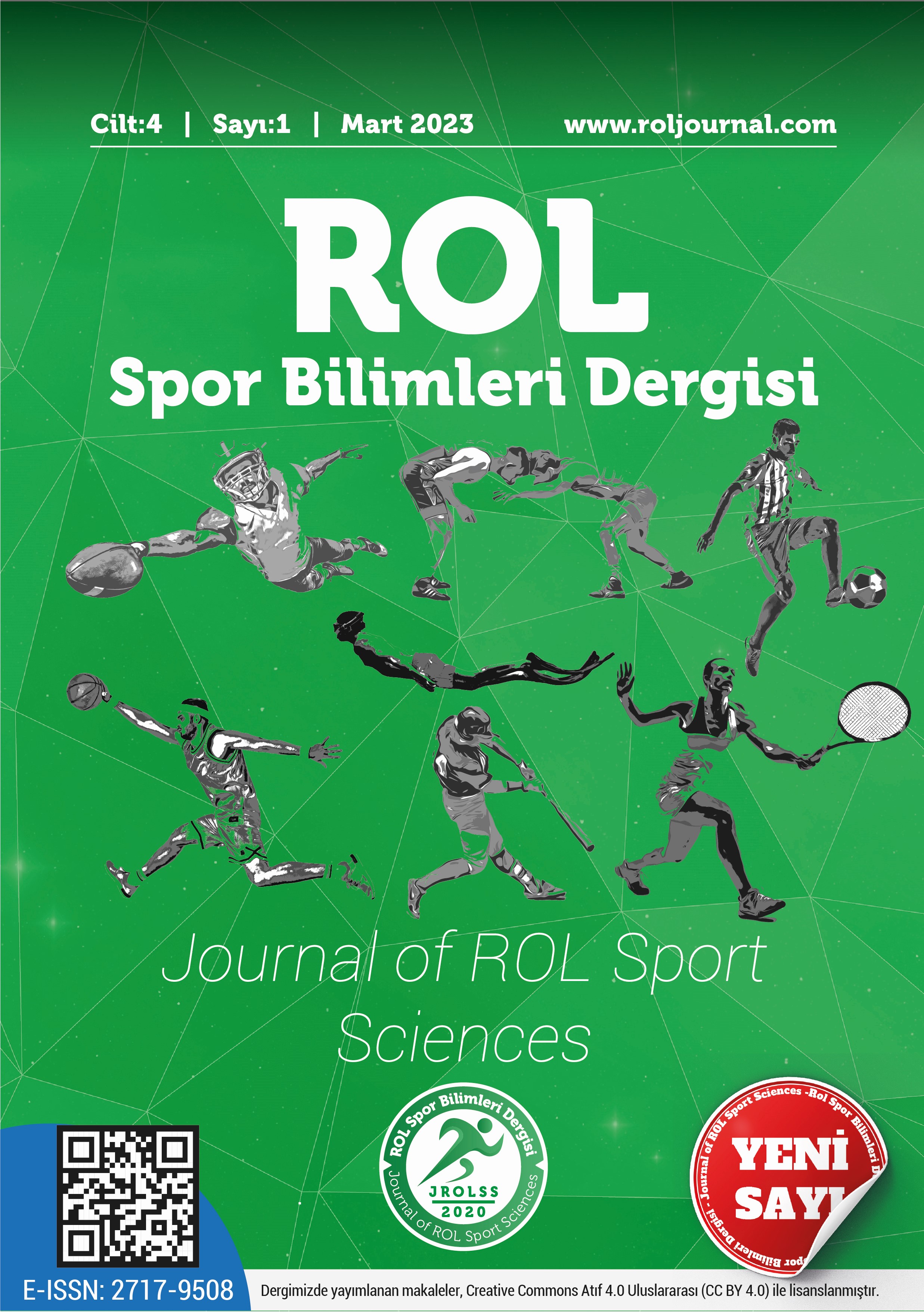2020 Tokyo yaz olimpiyat oyunları badminton kadınlar: Notasyonel analiz
DOI:
https://doi.org/10.5281/zenodo.7741127Anahtar Kelimeler:
Badminton, Müsabaka Analizi, Olimpiyat OyunlarıÖzet
Çalışmanın amacı, 2020 Tokyo Olimpiyatlarında mücadele eden sporcuların hangi vuruşları daha sık kullandıklarını, hangi vuruşlarda sayı kazandıklarını ve kaybettiklerini, oyun süreleri ve ralliler arasındaki ölü oyun sürelerinin nasıl bir seyirde olduğunu analiz etmektir. Çalışmada Tokyo Olimpiyat oyunlarında tek kadınlar kategorisinde çeyrek final, yarı final ve final müsabakalarında oynanan 8 maç analiz edilmiştir. Her bir maç, video analizcileri arasında tutarlılığı sağlanmış iki kodlayıcı tarafından incelenmiştir. Kodlama vuruş çeşitleri olarak; kısa servis, yüksek servis, lop-lift, net drop, net kill, savunma, drive, smaç, clear ve drop vuruşları ile birlikte müsabakada oynanan maçların süreleri de analiz edilmiştir. Elde edilen verilerin yorumlanmasında tanımlayıcı istatistik, ortalama, standart sapma ve yüzde değerleri kullanılmıştır. Araştırma sonucunda kadınların en çok lop vuruşu yaptıkları görülürken, yüzde olarak en çok sayı kazanılan vuruşun smaç vuruşu olduğu, en çok sayı kaybedilen vuruşun ise lop-lift vuruşu olduğu gözlemlenmiştir. Oyunlarda ortalama ralli süresi 12,28±9,23 sn. olurken bu süre içerisinde ortalama 12,19±8,85 vuruş yaptıkları, vuruş sonrasında 26±13,71 sn. dinlendikleri ortaya koyulmuştur. Tokyo Yaz Olimpiyat Oyunlarında badminton kadınlar branşında daha uzun dinlenme aralıkları görülürken vuruş frekansı şiddetinde artış olduğu tespit edilmiştir.
Referanslar
Abdullah, M.F., Janep, M., Azzfar, M.S., Karim, Z.A., Rahmat, A., & Nadzalan, A.M. (2018). Playing pattern analysis of men’s single badminton matches. International Journal of Engineering and Technology, 7(2.15), 168-170.
Abdullahi, Y., & Coetzee, B. (2017). Notational singles match analysis of male badminton players who participated in the African Badminton Championships. International Journal of Performance Analysis in Sport, 17(1-2), 1-16.
Abian-Vicen, J., Castanedo, A., Abian, P., & Sampedro, J. (2013). Temporal and notational comparison of badminton matches between men’s singles and women’s singles. International Journal of Performance Analysis in Sport, 13(2), 310-320.
Abian-Vicen, J., Sanchez, L., & Abian, P. (2018). Performance structure analysis of the men’s and women’s badminton doubles matches in the Olympic Games from 2008 to 2016 during playoffs stage. International Journal of Performance Analysis in Sport, 18(4), 633-644.
Arslan Y. (2019). Yeni başlayanlar için badminton el kitabı. Ankara: Gazi Kitapevi.
Arslanoğlu, E., Arslan, Y., & Şenel, Ö. (2009). 2008 Pekin Olimpiyat Oyunları badminton müsabakalarının analizi ve 2004 olimpiyatlarıyla karşılaştırılması. Spormetre Beden Eğitimi ve Spor Bilimleri Dergisi, 7(2), 77-84.
Aydogmus, M., Arslanoglu, E., & Senel, O. (2014). Analysis of badminton competitions in 2012 London Olympics. Turkish Journal of Sport and Exercise, 16(3), 55-60.
Galeano, J., Gomez, M.Á., Rivas, F., & Buldú, J.M. (2021). Entropy of Badminton Strike Positions. Entropy, 23(7), 799.
Gawin, W., Beyer, C., & Seidler, M. (2015). A competition analysis of the single and double disciplines in world-class badminton. International Journal of Performance Analysis in Sport, 15(3), 997-1006.
Gómez, M.Á., Rivas, F., Leicht, A.S., & Buldú, J. M. (2020). Using network science to unveil badminton performance patterns. Chaos, Solitons and Fractals, (135), 109834.
Gómez, M.A., Cid, A., Rivas, F., Barreira, J., Chiminazzo, J.G.C., & Prieto, J. (2021). Dynamic analysis of scoring performance in elite men's badminton according to contextual-related variables. Chaos, Solitons & Fractals, (151), 111295.
Gülmez, İ. (2008). Her yönüyle badminton. Ankara: Neyir Matbaacılık.
Hazar, F. (2005). Badmintonda çevikliğin performansa etkisi ve geliştirilmesine yönelik antrenman uygulamaları. [Doctoral Dissertation, Marmara University], İstanbul.
Hughes, M., Hughes, M.T., & Behan, H. (2007). The evolution of computerised notational analysis through the example of racket sports. International Journal of Sports Science and Engineering, 1(1), 3-28.
Lee, K.T., Xie, W., & Teh, K.C. (2005). Notational analysis of international badminton competitions. In ISBS-Conference Proceedings Archive, 387-390.
Özdemir, A.G. (2020). 5.-12. sınıf öğrencilerinin gelişim düzeyine uygun badminton teknik ve taktiklerinin belirlenmesi. [Master's thesis, Karamanoğlu Mehmetbey Üniversitesi], Karaman.
Özgür, B. (2019). 17 ve 19 yaş altı kadın milli badminton oyuncularının müsabaka sırasında yaptıkları basit hataların karşılaştırılması. Spor e Performans Araştırmaları Dergisi, 10(2), 123-130.
Pardiwala, D.N., Subbiah, K., Rao, N., & Modi, R. (2020). Badminton injuries in elite athletes: A review of epidemiology and biomechanics. Indian Journal of Orthopaedics, 54(3), 237-245.
Phomsoupha, M., & Laffaye, G. (2015). The science of badminton: game characteristics, anthropometry, physiology, visual fitness and biomechanics. Sports Medicine, 45(4), 473-495.
Salman, M.N., & Salman, S. (2009). Badminton sporunda oyun kazandıran vuruşların bölgesel dağılımının cinsiyet faktörü açısından karşılaştırması. Selçuk Üniversitesi Beden Eğitimi ve Spor Bilim Dergisi, 11(2), 7–12.
Salman, M.N., Tunç, G.T., Salman, S., Koç, M., & Taşçı, C. (2018). The diversity of rally kicks of olympic badminton athletes, the analysis of loading and resting relationship. Socıal Mentalıty And Researcher Thinkers Journal, 12(4), 736-747.
Sañudo, B., De Hoyo, M., & Carrasco, L. (2008). Demandas fisiológicas y características estructurales de la competición en pádel masculino. Apunts. Educació física i esports, (94), 23-28.
Supriyanto, N.A., & Rasyid, A. (2018, December). Characteristics analysis of badminton in female single player. In 2nd Yogyakarta International Seminar on Health, Physical Education, and Sport Science (YISHPESS 2018) and 1st Conference on Interdisciplinary Approach in Sports, 486-488.
Türkeli, A., Şenel, Ö., & Gülmez, İ. (2019). Rio Olimpiyat Oyunlarında badminton müsabakalarının incelenmesi. Spor ve Performans Araştırmaları Dergisi, 10(3), 242-255.
Valldecabres-Hermoso, R., Benito-Trigueros, A.M.D., Casal-Sanjurjo, C.A., & Pablos-Abella, C. (2019). Diseño y validación de una herramienta observacional para el bádminton (BOT). Revista Internacional de Medicina y Ciencias de la Actividad Física y el Deporte, 74(19), 209-233.
Valldecabres, R., Benito, A.M.D., Losada, J.L. & Casal, C.A. (2020a). Badminton World Championship stress zones and performance factors: The key to success through log-linear analysis. Journal of Human Sport and Exercise, 17(1).
Valldecabres, R., Casal, C.A., Chiminazzo, J.G.C. & De Benito, A.M. (2020b). Players’ on-court movements and contextual variables in badminton world championship. Frontiers in Psychology, 11, 1567.
Van der Mars, H. (1989). Observer reliability: Issues and procedures. In P. Darst, D. Zakrajsek, & V. Mancini (Eds.), Analyzing Physical Education and Sport Instruction, (2), 53-80.
Yüksel, M.F. (2019). A notional analysis in badminton sport: How the hit preferences affect the competition performance? Journal of Athletic Performance and Nutrition, 6(2), 29-43.
İndir
Yayınlanmış
Nasıl Atıf Yapılır
Sayı
Bölüm
Lisans
Telif Hakkı (c) 2023 ROL Spor Bilimleri Dergisi

Bu çalışma Creative Commons Attribution 4.0 International License ile lisanslanmıştır.

